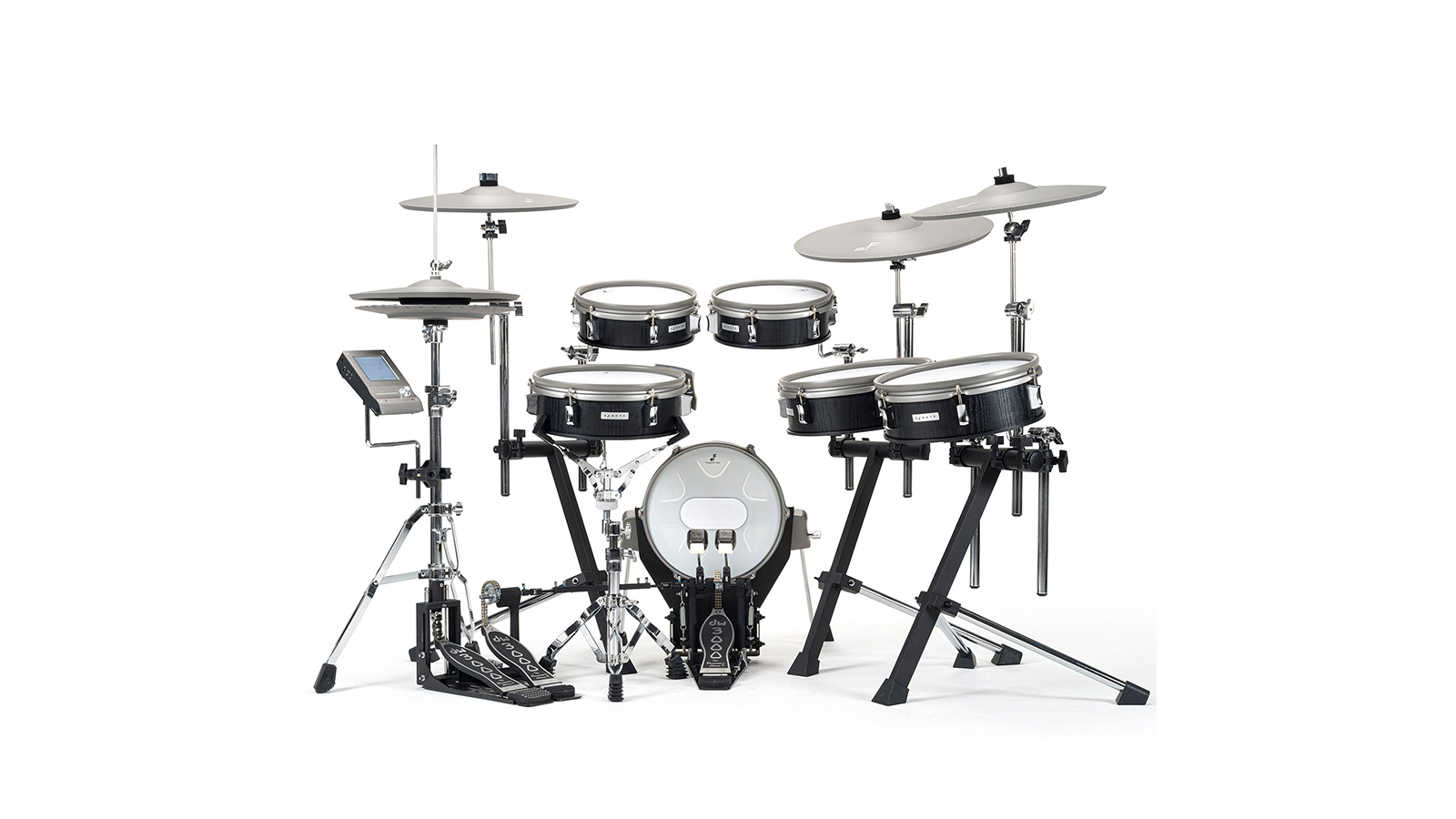MusicRadar Verdict
EFnote product designers have taken their decades of experience in the electronic drum market and created a kit that is both visually striking and seriously impressive in the hardware stakes - particularly the cymbals. The module has a couple of niggles and we don’t love the tripod mounting system, but when a kit feels and sounds this good to play, we can let that slide.
Pros
- +
Limited but high quality selection of stereo sounds
- +
Loads of editing options
- +
We love the side rim attachment on the snare
- +
Hi-hat and cymbal pads are fantastic
Cons
- -
Minimalist module means lots of menu diving
- -
Module touchscreen isn’t the most sensitive
- -
We weren’t big fans of the tripod stands
MusicRadar's got your back
EFnote 3x review: What is it?
The 10-piece 3X is the first kit from fledgling electronic drum set brand EFnote to come through the MusicRadar testing studio, but the Japanese company has actually been around since 2018. EFnote’s founders and product designers bring a wealth of experience from previous roles at Roland and ATV Drums, so it’s safe to say they’ve hit the ground running.
The EFnote 3X sits one up from the bottom rung of EFnote’s range of kits. Beneath the 3X is the 3, then above you have the 5, 5X, 7, 7X and Pro models. The higher up the roster you climb the more hardware upgrades you get, including things like real drum shells, effects e-cymbals, two-piece stand-mounted hi-hats and more. The EFnote module is fundamentally the same throughout each range, but the 5 series comes with more pre-loaded kits and greater capacity for user kits, while the 7 series module includes upgraded multi-layer samples.
Perusing the full EFnote range it’s clear the brand wants to disrupt what we know about how e-drums should look and further bridge the gap between electronic and acoustic drums. In the same way that Roland has embraced real drum shells with its VAD Series, it’s only EFnote’s 3 and 3X models that feature shallow electronic pads, while all the other kits have full acoustic shells. Cymbal pads and drum hoops are also finished in grey, which helps EFnote stand out in a sea of black from other manufacturers.
EFnote is also the only company right now who can offer such a wide spread of electronic cymbal options, with sizes including an 8” splash, a 17” effects cymbal complete with holes à la Sabian’s O-Zone, right up to a whopping 20” ride cymbal - the current largest cymbal offering from any e-kit manufacturer. We're also told that there's an 18" dual-zone China pad coming later in the year too.
None of EFnote’s kits can be classed as ‘beginner’ or ‘budget’. Their range is aimed squarely at drummers who need a powerful tool for practise and recording with high quality sounds and a huge range of editing options, and possibly even a kit for gigging. Case in point, the cheapest kit on offer - the EFnote 3 - currently costs around $2,200/£2,180, while the 3X retails for around $2,899/£2,700. Intrigued as to whether this is a deliberate move, we reached out to EFnote product manager Andreas Deutinger who told us, “there is no interest in the entry-level market. The EFnote brand focuses primarily on the high-end and the upper mid-range segment.” So don’t expect a $/£500 beginner kit anytime soon.
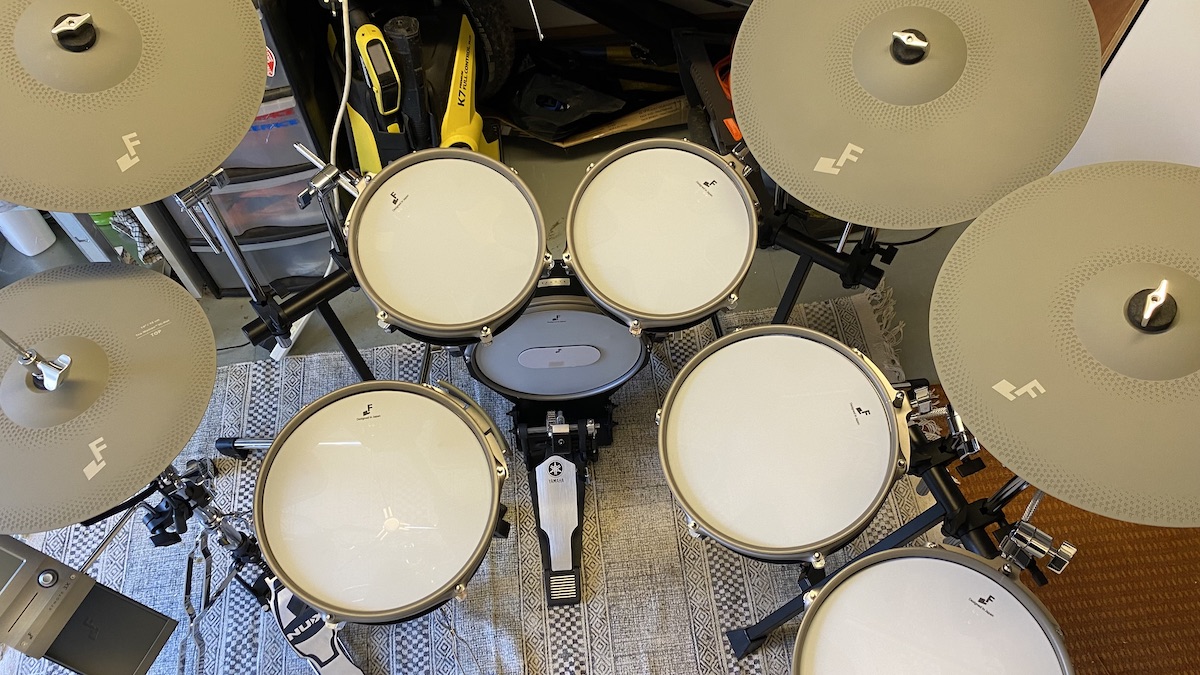
So, that’s the background. What about the kit we have for review? The EFnote 3X is a 10-piece setup comprising: 12”x4” single-zone kick drum; a 12”x4” triple-zone stand-mounted snare; 2x 10”x3.5” dual-zone toms; 2x 12”x4” dual-zone toms; 14” triple-zone stand-mounted hi-hats with optical sensors; 2x 16” triple zone crashes; 18” triple zone ride.
Each drum pad features a double-layer mesh head, grey hoops topped with a rubber rim and sturdy Monocoque drum shells with black oak-style finish. Visually the grey rims match perfectly with the pristine white heads, while the wood grain texture on the shells looks fantastic.
In a further bid to stand out in a crowded market, every EFnote snare pad comes complete with a side-rim pad attached. It reminded us of the old Yamaha Groove Wedge and is designed to make light work of crosstick or provide an extra surface for triggering sounds. It’s a fun way to experiment and blends nicely with the curve of the main pad.
The module is a head-turner, too. There’s a metal chassis with brushed aluminium finish and a thoroughly minimalist approach to controls. It’s somewhat reminiscent of ATV’s aD5 module - understandable considering some of ATV’s crew now work for EFnote. There’s just a single power/control knob on the front of the module, and that’s because this unit has a touchscreen. It really is a stunning piece of hardware, but there’s plenty going on under the hood too. You can read more about that in our module section below.
EFnote 3x review: Performance & verdict
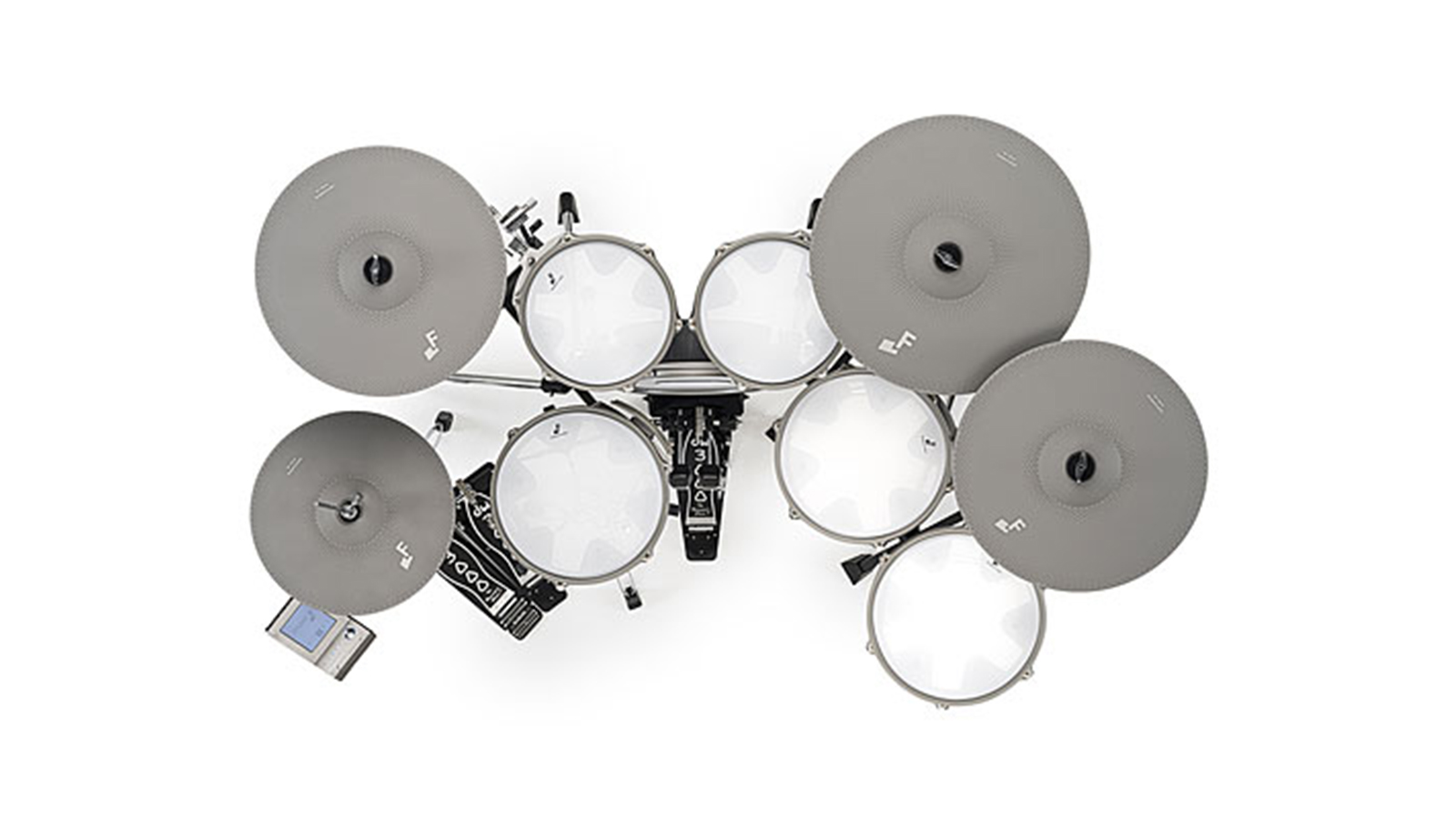
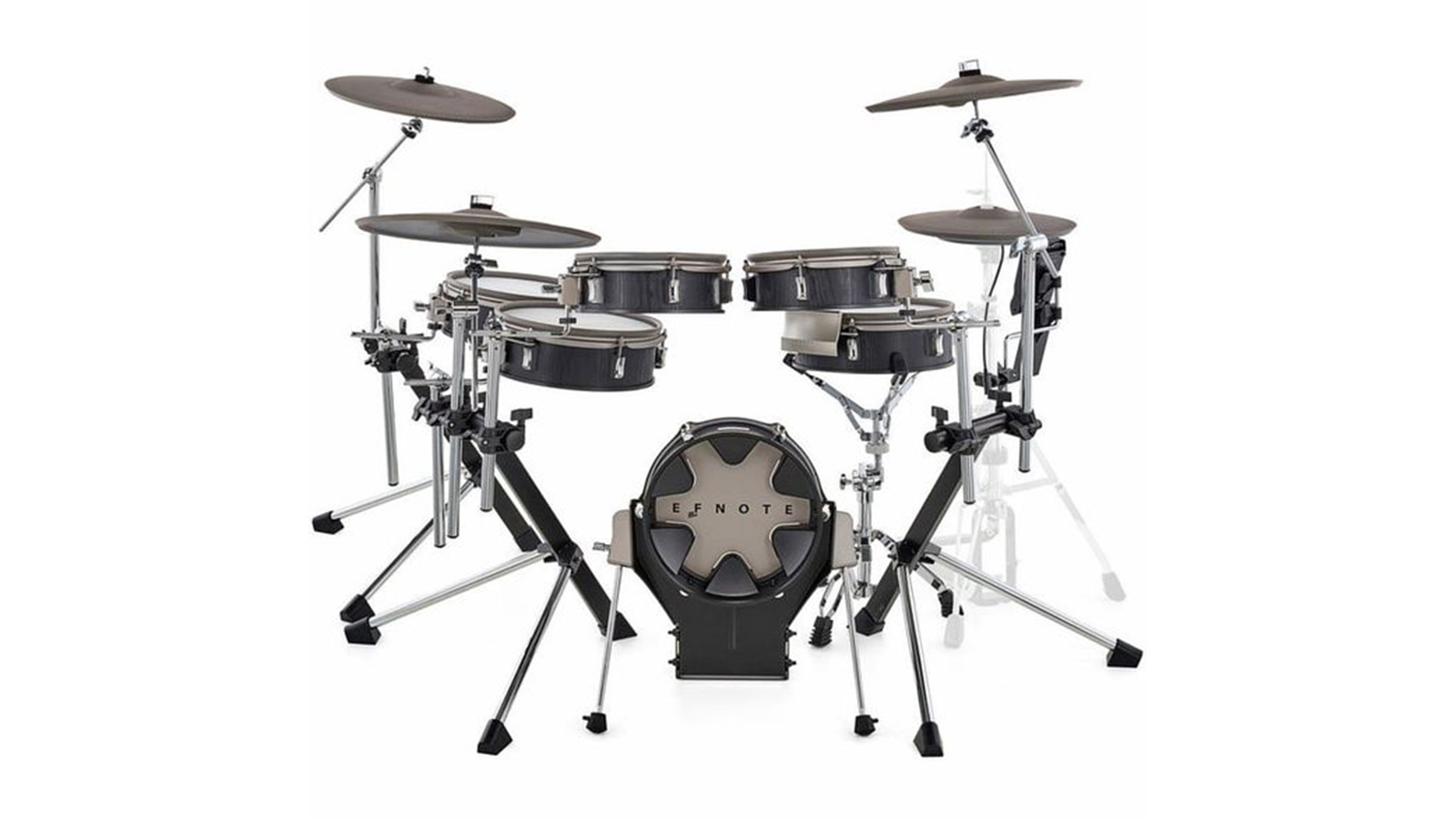
Unboxing & building
The kit arrived in three boxes and took around 90 minutes to unpack and build. The first thing we notice is how big the kit footprint is. If you’re thinking of pulling the trigger you need to be sure you have the space for a 10-piece kit with full-size cymbals, plus stand mounted hi-hat and snare pad. If not then you could consider something more compact like Roland’s TD-27KV2 which has smaller (and one fewer) tom pads, smaller crashes and costs around the same as the EFnote 3X.
There’s plenty of adjustment available on the bass drum tower and the 12”x4” pad is large enough to comfortably fit a double kick pedal. There’s even a beater patch pre-installed on the pad (with a spare in the box). Not only does this preserve the mesh, but it also helps reduce the typical bounce you get from playing directly onto a mesh kick drum head.
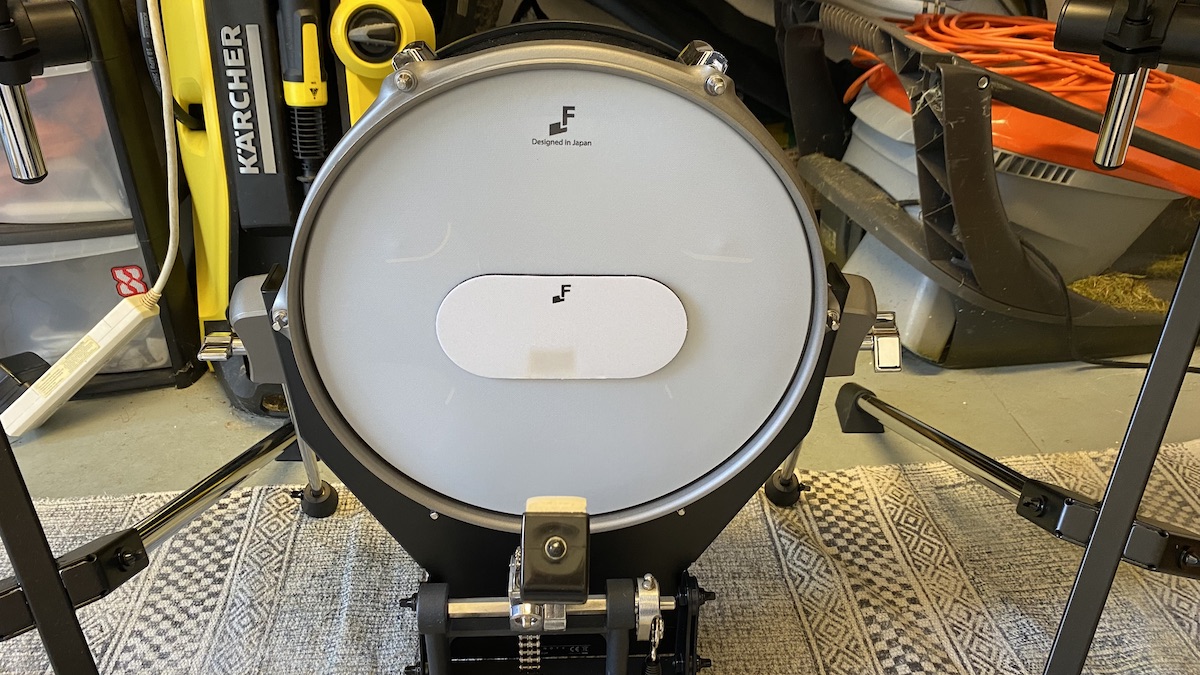
While there’s a perfectly functional snare stand included, EFnote has chosen not to include a kick pedal or hi-hat stand in the 3X package, but realistically most drummers investing at this level will already have a stack of hardware to choose from as well as personal preferences when it comes to pedals.
Unique to EFnote’s 3 Series drums is the use of three tripods to mount pads rather than a typical rack. EFnote tells us this is to “improve flexibility”. The tripods themselves are easy to construct, with two legs bolted to a central angled post using a supplied drum key. At the top of each tripod is a horizontal bar complete with tom and cymbal arms on which to mount your pads. The module mounts separately to the hi-hat stand.
While we’re all about thinking outside the box, honestly first impressions are that we don’t love the tripods. With enough tinkering you can get the pads positioned where you want them and the tripod legs lined up neatly, but it takes time. It makes you realise that while racks aren’t the most stylish, they just work.
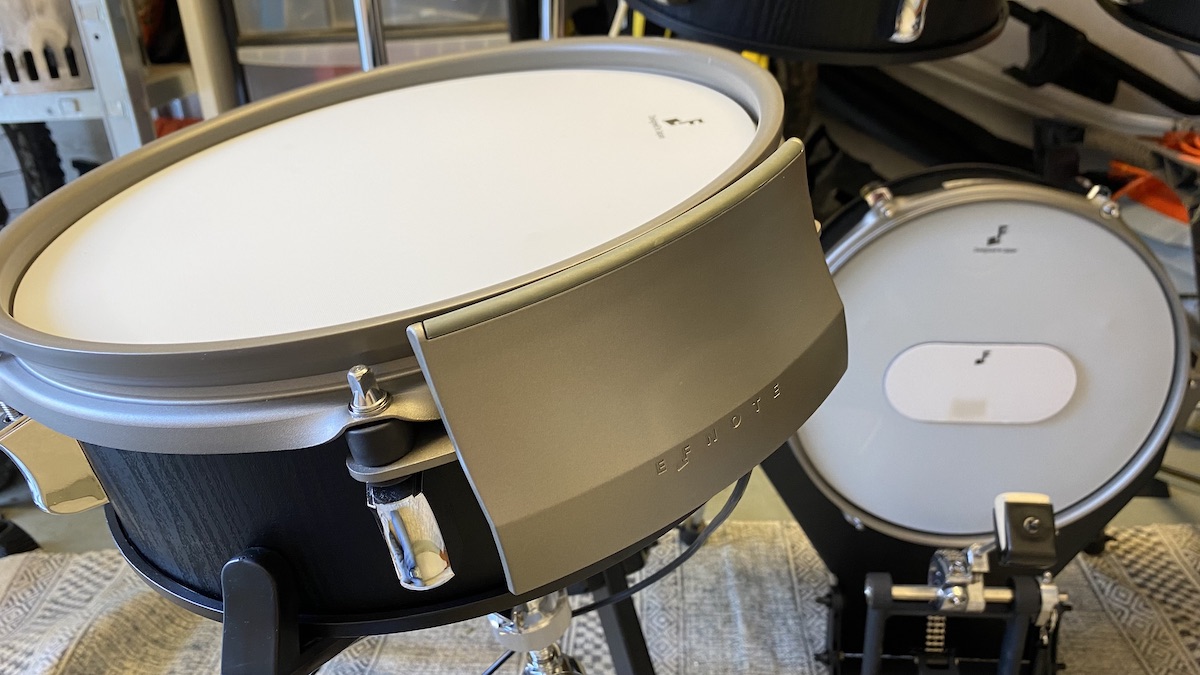
In our experience a well-engineered rack feels totally planted and fills you with confidence that nothing will move, whereas the tripods feel like three potential areas of weakness. On more than one occasion the far right tripod - loaded with two toms and a 16” crash cymbal - tipped backwards under the weight as we were trying to move it into the correct position.
For the perfectionists out there, a rack also has the benefit of horizontal bars for keeping cabling relatively tidy, or in some cases internal cable routing to hide the wiring altogether. The tripod approach means that cables for the floor toms, the ride and second crash dangle down towards the bass drum pad and trail along the floor on their way to the back of the module. If you like symmetry and clean lines, this will really grind away at your OCD.
Once we’ve navigated the tripod niggles and have everything set up as we’d like we’re happy to put our prejudices aside - sat behind it on our drum throne the EFnote 3X is a seriously inviting kit. The splay of large pads with pristine white heads, the large grey cymbals, the blue glow from the module screen - this kit really wants you to get stuck in.
The EFnote module - usability & sounds

Whereas some modules, particularly at the beginner end of the spectrum, are bloated with sounds that you’ll play once and never use again, the full stereo kits native to the EFnote module are - almost without exception - very practical for most real-world playing scenarios out of the box. Studio F is the everyman kit, well mixed and designed to work in most settings; it’s a kit we could play for hours. Rockin’ Road Trip is more bombastic for fat guitar-driven grooves and even bigger fills, while FunQ is dry and tight. Then you have the Recording kit which is clean and taught with a tasteful dash of reverb, while Maple is simply gorgeous.
There might only be 16 kits on board, but you’ll quickly find something that works. And of course, you’re not limited to these kits alone. You can add a range of effects including reverb, ambiance and EQ, as well as muffling and tuning to existing kits, or build your own custom kits, picking and choosing the right components, layering up samples and dialling in your ideal sound.
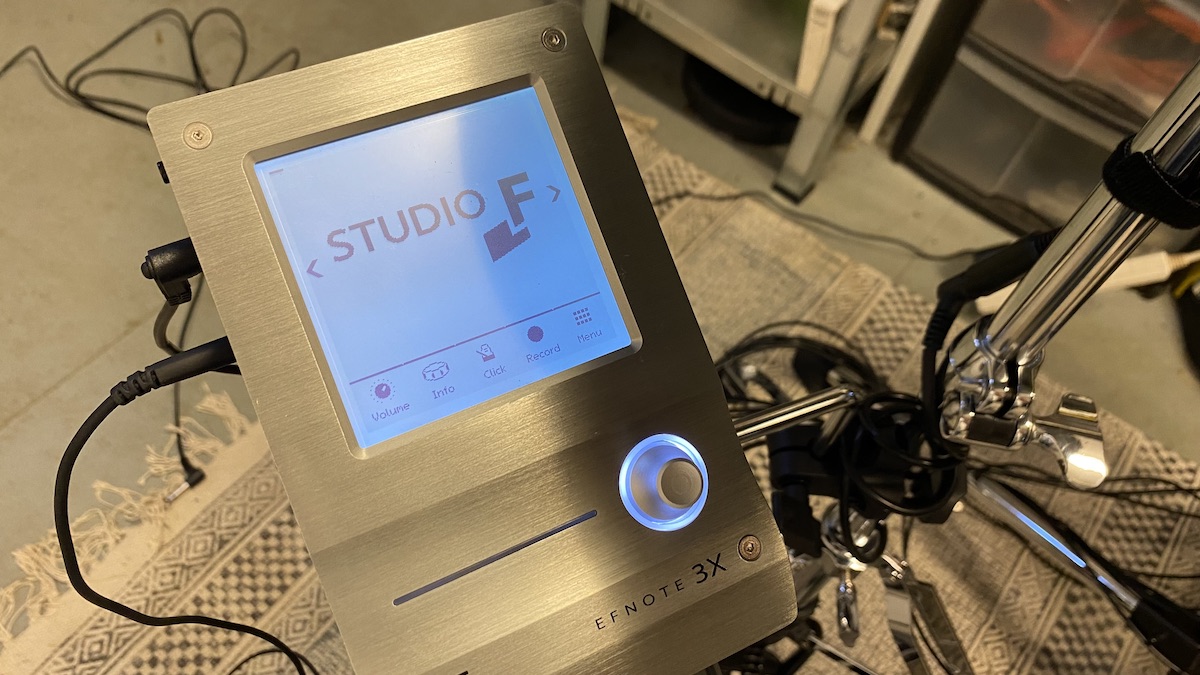
Currently there is no option for importing your own samples, which is a missed trick at this level, but you can download additional kits created by EFnote using the free EFnote Tools app. There are currently only four free kits to download for the 3X, but it’s easy to beam them to the module and get playing. EFnote couldn’t provide any information about more kits coming to the app further down the line. We’d like to see a varied library of kits in the future - then this would be a truly headline feature.
As previously mentioned, the module is a thing of minimalist beauty, but that minimalism does raise issues when it comes to navigating menus and editing kits. The main input and control method is the touchscreen - an exciting proposition in a world of modules covered in buttons, faders and manual controls - but unfortunately it’s not particularly sensitive. Running the screen calibration process improves things a little, but this doesn’t feel like something the user should have to fix, it should just work out of the box. You get used to it, but don’t go expecting the same degree of touch sensitivity as your smartphone. It’s closer to the experience of using a Kindle eReader, sometimes requiring multiple presses or hard prods to get where you need to go.
In terms of menu layout, it’s mostly really intuitive and there are helpful touches like keeping go-to functions such as volume, click track and the ability to record straight into the module, easily accessible from the main screen of each kit. For deeper editing you have to dive a little further in and get used to things, but it becomes muscle memory without much trouble. The single knob on the font of the module is also handy for quickly scrolling through menu items.
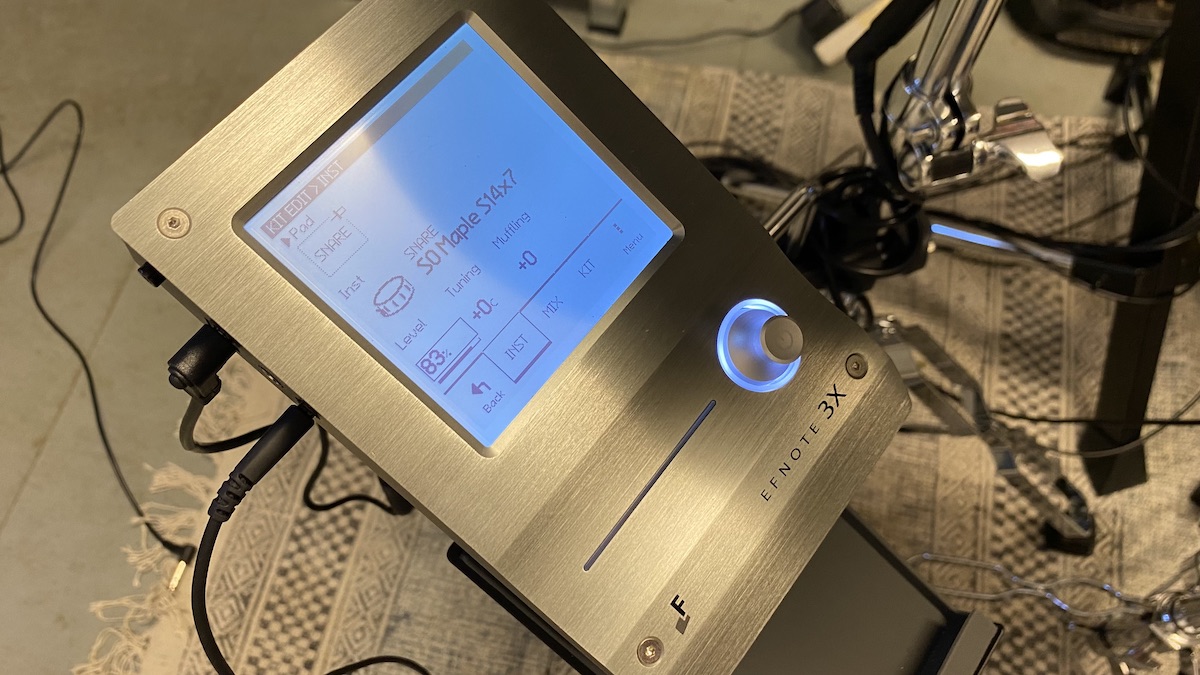
So, this kit certainly isn’t designed for speedy changes on the fly. You’ll need to take some time before you play to really dial in the finer points of your sound, but then it’s a case of set and forget, leaving you to get on with playing. And maybe that’s the point. There are so many ‘acoustic’ touches to this kit - large pads, shells, two-piece hi-hat, stand-mounted snare and realistic sounds, so perhaps EFnote wants you to find your sound, then forget about the module altogether and just immerse yourself in playing?
The EFnote 3X isn’t just a high-end practice tool, it’s a powerful recording kit too. You can send eight channels of separated audio via a USB cable to a computer. You can also record both the eight channels of audio and raw MIDI from the kit if you’re planning on using a virtual instrument like Superior Drummer 3. We hooked the module up to SD3 and found it super easy to do with an EFnote profile already available.
Do we like the module? Overall yes we do. There's plenty of tweakability for diving deep into your sound and the clean lines and lack of buttons is a cool alternative to the mainstream, but it will really come into its own when EFnote addresses the touchscreen issue.
Playability
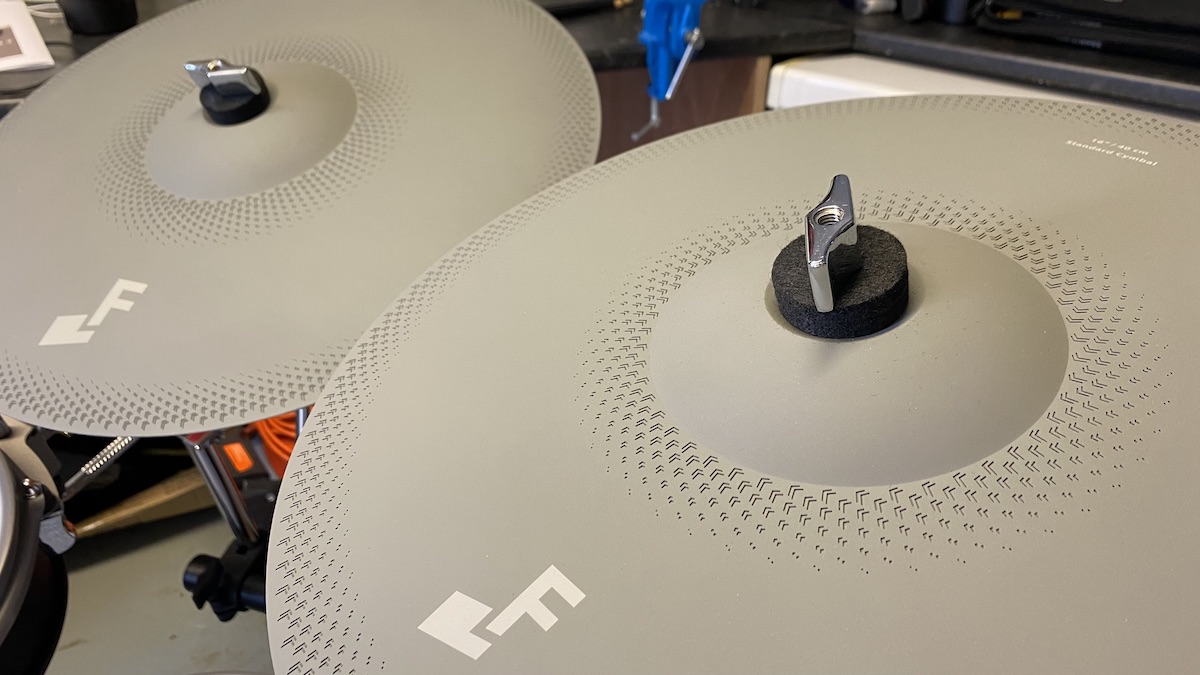
The pads themselves look fantastic with premium finishing and they feel great under stick. We’re very used to mesh heads by now and the double-plys topping this kit feel like a robust coated acoustic head, something you can really lay into. The silicone rubber on both the drum pad rims and cymbal pads feels durable and we’re yet to leave a stick mark.
For us it’s the cymbal pads that are the biggest coup of this kit - they feel absolutely wonderful to play. All too often the rubber coating of e-cymbals means a less realistic feel, but the EFnote cymbals feel pretty hard under stick, like a regular metal cymbal. Close your eyes and play the 18” ride and it feels like you’re tapping away at a K Custom. All the cymbals have a pleasing natural swing to them and the 360-degree playing area ensures you always get a sound, wherever you strike it. The choke zone is accessible wherever you grab the cymbal too.
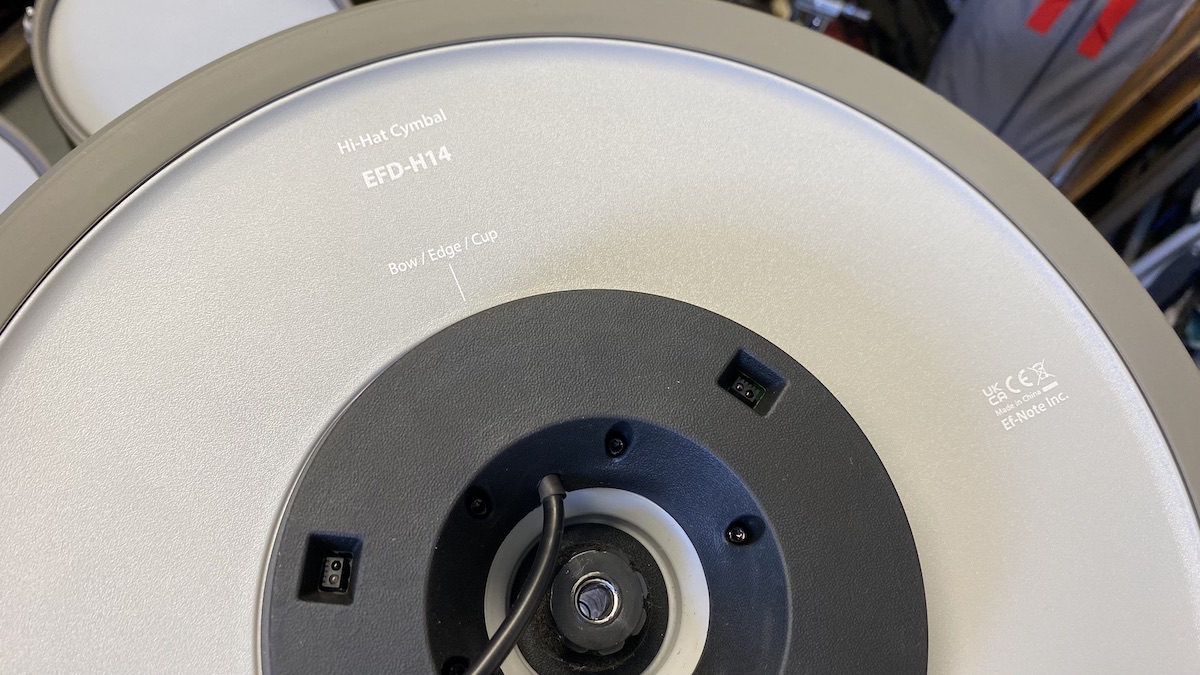
The hi-hat comes in two parts, with a plastic bottom half that sits on your hi-hat stand, with a rubber pad - complete with three sets of optical sensors - up top. EFnote says the sensors capture the motion of the cymbal in 3D. In practice the hi-hats are really articulate with plenty of nuance between fully closed and fully open. Stepped hats sounds crisp and precise too.
The module houses what EFnote calls the Elise Sensing Processor which is designed to react realistically and consistently to every stroke with zero latency. On the whole we found the feedback from our playing to be dynamic, with natural recreation of the nuances of each stroke, particularly on the cymbals. We experienced a little machine gunning as we built up to faster rolls, mainly on the snare, but overall this is a very natural sounding e-kit.
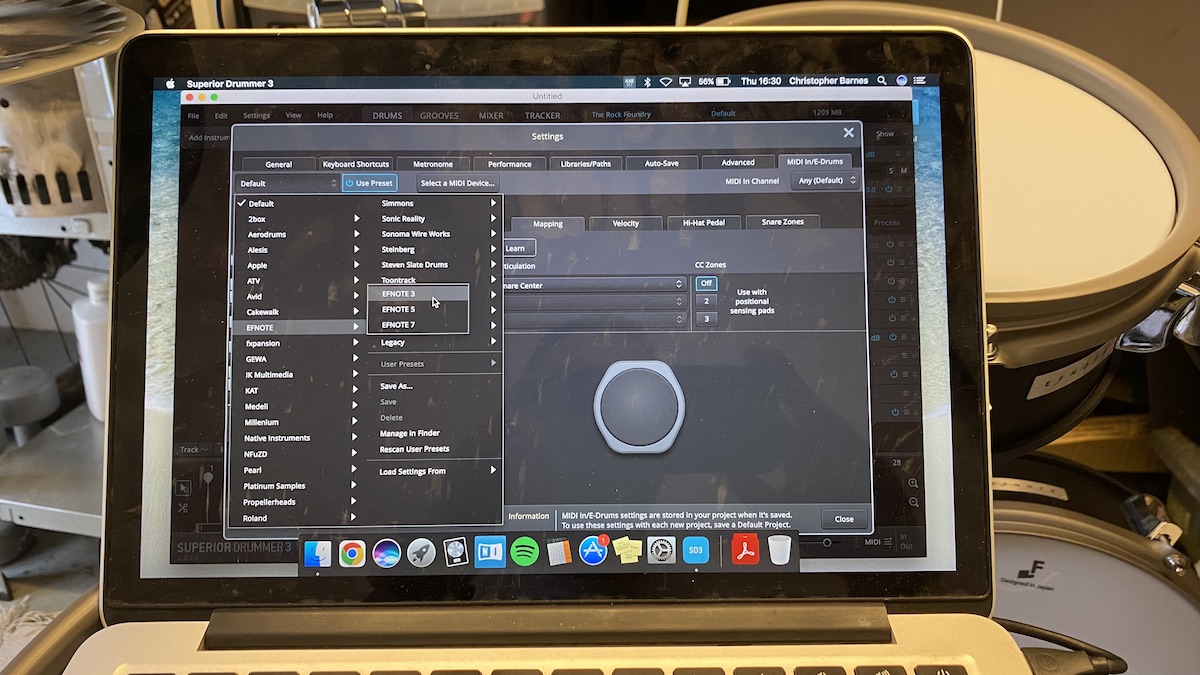
Other notable features
For gigging drummers there’s a cool Setlist function in the module, enabling you to create a playlist of your favourite kits so you can easily call them up between songs during a gig or rehearsal. We found it to be just as useful for home practice too, easily cycling between our favourite kits.
As with most modern kits, the module also has Bluetooth for connecting a smart device and streaming tunes and backing tracks via Spotify, YouTube etc. This really is a cool feature that still brings a smile to the face. A neat touch is the inclusion of a small accessories tray that sits beneath the module. This is primarily designed for resting your smartphone, but could just as easily be a spot for a drum key or your in-ear monitors.
Verdict
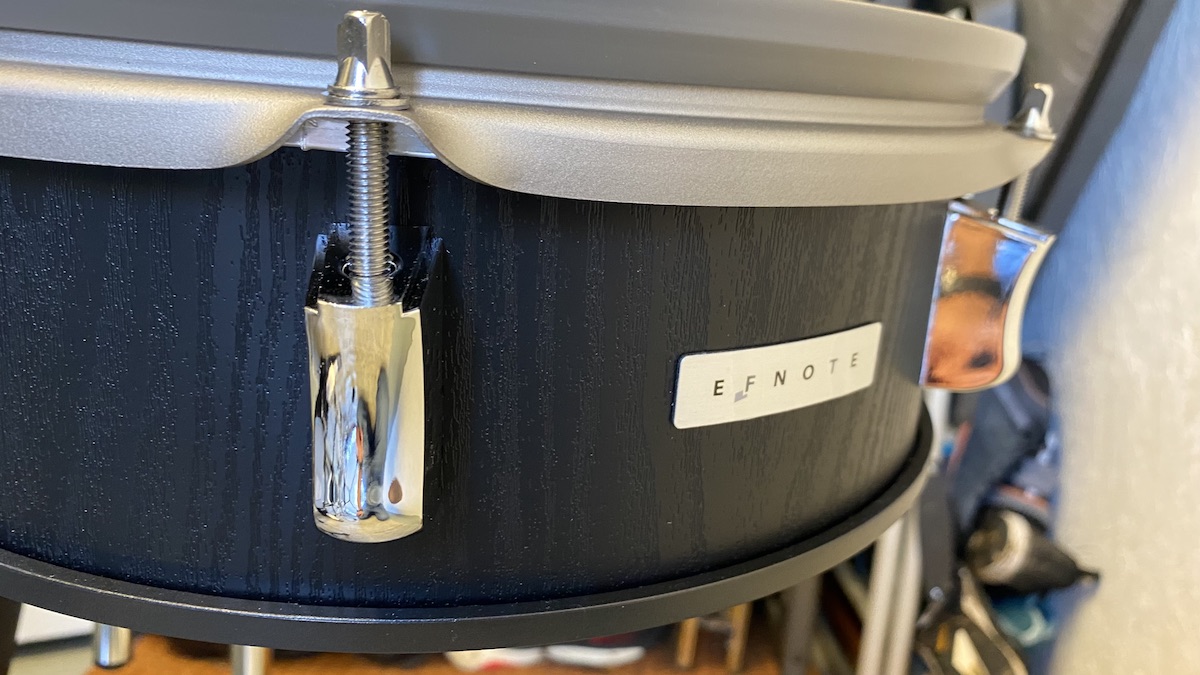
Many e-kits focus on small pads and a compact footprint. This is fine if you’re tight on space, but if you’re looking for a true acoustic kit experience in electronic form, larger pads and cymbals are the only way to go. Despite our indifference to the tripod system, and some niggles with the module touchscreen, the EFnote 3X nails this brief.
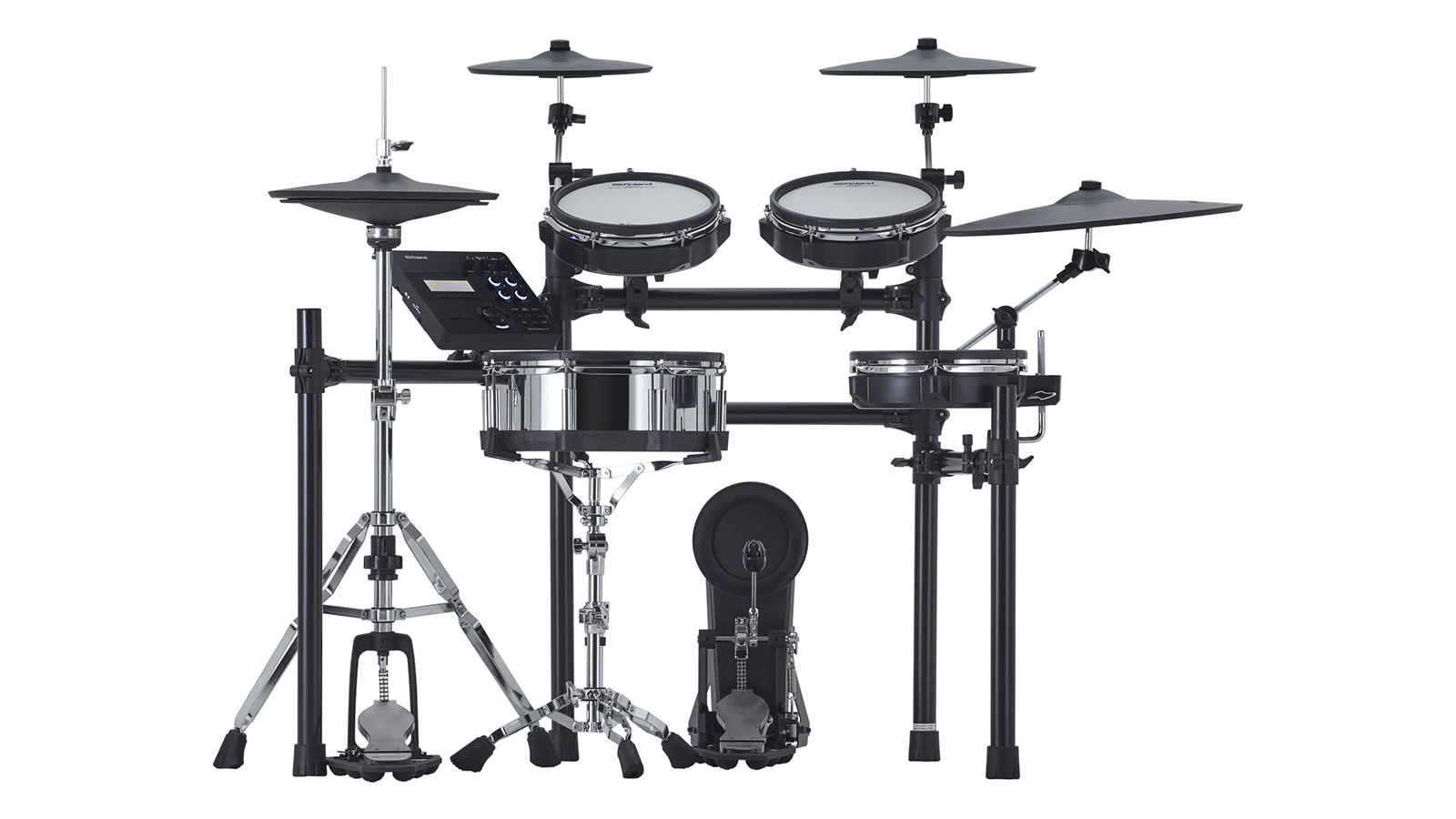
Roland TD-27KV2
Yamaha DTX8K-X
Alesis Strike Pro
Aesthetically, this kit is ahead of the game and we love the included extras like the accessories tray and snare drum side-rim. EFnote designers have learned plenty from their years in the business and clearly plan on evolving the sector and challenging the competition.
In terms of where this kit sits in the market, similar money will buy you the Roland TD-27KV2. It’s more of a traditional looking e-kit with fewer pads than the EFnote, but we’re big fans of the TD-27 module and the inclusion of a digital snare and hi-hats. You could also go all in on the Yamaha DTX8K-X. Yamaha hardware is world-renowned so you know the kit will stand its ground, while the wood shells deliver that acoustic-electric crossover and the sounds are some of the best in the business.
Right now we’d say that the EFnote kit is a worthy competitor to the brands mentioned above. They’re a company doing things differently - bringing a visual cool to the e-kit market with powerful, capable, great-looking gear that sounds fantastic - and this kit really embodies that. So, if you’re sitting on an intermediate to pro-level budget, EFnote should definitely be on your list for consideration.
Audio demos
We've picked three of our favourite kit sounds and recorded some playing so you can hear this kit in action.
EFnote 3X review: Hands-on demos
drumtec-TV
Edrumcenter
Artesia Pro
EFnote 3X review: Specifications
- Configuration: 12”x4” single-zone kick drum pad; a 12”x4” triple-zone stand-mounted snare pad; 2x 10”x3.5” dual-zone tom pads; 2x 12”x4” dual-zone tom pads; 14” triple-zone stand-mounted hi-hat pad with optical sensors; 2x 16” triple zone crash cymbals; 18” triple zone ride cymbal
- Kits: 16
- User kits: 34
- Editing parameters: Level, Pan, Tuning, Muffling (for each pad), 2-Band EQ (for each pad), Ambience Effect (8 Types), Pad Layer
- Connectivity: USB MIDI In/Out, Bluetooth Audio Input, Bluetooth MIDI In/Out, MIDI Out: 5-pin DIN, USB Audio: 8-ch Output / 2-ch Input (Mac/Windows ASIO)
- Contact: EFnote
I'm MusicRadar's eCommerce Editor. In addition to testing the latest music gear, with a particular focus on electronic drums, it's my job to manage the 300+ buyer's guides on MusicRadar and help musicians find the right gear for them at the best prices. I dabble with guitar, but my main instrument is the drums, which I have been playing for 24 years. I've been a part of the music gear industry for 20 years, including 7 years as Editor of the UK's best-selling drum magazine Rhythm, and 5 years as a freelance music writer, during which time I worked with the world's biggest instrument brands including Roland, Boss, Laney and Natal.
“Every note counts and fits perfectly”: Kirk Hammett names his best Metallica solo – and no, it’s not One or Master Of Puppets
Ranked: Bon Iver's albums, from Sable, Fable to For Emma, Forever Ago
“Its mission is simple: unleash the power of any amplifier or line-level source without compromise”: Two Notes promises a “watershed” in tube amp control with the Torpedo Reload II
